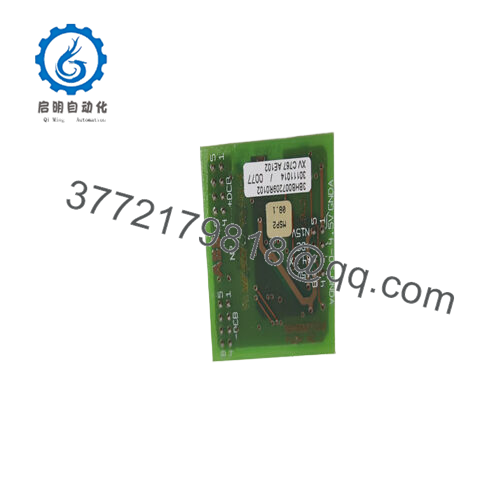Description
In the intricate ecosystem of excitation systems for synchronous machines, where voltage fluctuations or field current instabilities can destabilize entire grids—envision a thermal power station where excitation transients during sudden load rejections cause under-voltage dips and turbine trips, or a hydro facility where imprecise reactive compensation amid water flow variations risks rotor overheating and forced outages—these issues erode operational resilience and inflate recovery costs. Engineers in these setups often contend with legacy exciters that struggle with real-time tuning, leading to signal noise in feedback loops, coordination gaps with AVRs, or scalability limitations that hinder integrations in modern DCS environments. The ABB XVC767AE102 3BHB007209R0102 emerges as a pivotal voltage regulation control module within ABB’s EXC 2100E excitation framework, delivering adaptive field management and precise I/O signal processing to sustain generator stability under variable electrical demands.
This module proves vital in utility-scale applications like retrofitting static exciters for renewables curtailment, where modular voltage loops prevent sags without full bridge replacements, or in industrial synchronous motors needing de/excitation safeguards to avert overflux during startups. In a coal-fired plant’s main generator, for instance, it orchestrates field currents amid fossil fuel swings, ensuring high-reliability outputs that align with grid codes and avert penalties. For offshore wind synchronous converters exposed to saline vibrations, the ABB XVC767AE102 3BHB007209R0102 embeds diagnostics for thyristor health, fortifying process control in isolated networks. It’s a staple for phased expansions in multi-MW setups, where its hot-plug design minimizes intrusion, prioritizing goals like fault isolation in EMI-heavy or thermal-stressed enclosures.
Central to its strength in industrial automation is its focus on practical adaptability: supporting PID algorithms for ±0.5% regulation, it tunes across automatic, manual, and power factor modes without hardware swaps. In grid-volatile sites or arc-susceptible bays, its isolation clamps transients, while self-monitoring flags asymmetries early. For teams extending EXC 2100E lifespans, the ABB XVC767AE102 3BHB007209R0102 bridges eras, reusing backplane norms to cut reconfiguration, redirecting efforts from firefighting to fine-tuning in process control where voltage poise underpins every kilowatt.
Slipping the ABB XVC767AE102 3BHB007209R0102 into your excitation architecture casts it as the discerning regulator between the thyristor converter and AVR processor, where it modulates field voltages—up to 1000 VDC—via gate commands while relaying current/reactive data to the EXC core for loop refinement. This module integrates via the 2100E backplane in control racks, anchoring at the regulation interface—directly biasing bridge stages but upstreaming metrics through Profibus or analog ties to SCADA for holistic supervision. In a tiered stack, it allies with PSS units for damping or field sensors for flux oversight, distributing duties across redundant paths to dodge bottlenecks.
In flow, it deploys control routines at 8 kHz cadences, adjusting excitations for AVR or Q control to limit swings under 1% in faults, with relays for discharge or flashing interlocks. Insights route via LEDs and RS485, surfacing timings or drifts in ABB’s tools for distant dissection—pivotal in process control where HMI forensics trump site scrambles. Redundancy via duplex configs yields handovers under 25 ms, securing seamless de-ramps in synced gens, while online tuning avoids halts.
This seamlessness reaches varied infrastructures: embed it in IP20 cabinets with shielded runs, set bounds via onboard trims or loaders, and mimic transients to gauge ripple caps. For backplane pros, the ABB XVC767AE102 3BHB007209R0102 clarifies layers, morphing raw exciters into poised arbiters that scale with ratings, elevating industrial automation from fickle fields to steadfast strongholds.
| Specification | Details |
|---|---|
| Model Number | XVC767AE102 3BHB007209R0102 |
| Brand | ABB |
| Type | Voltage Regulation Control Module (EXC 2100E) |
| Input Voltage | 24 VDC |
| Operating Temp Range | -5°C to 55°C |
| Mounting Style | Backplane / Rack |
| Dimensions | 180 x 120 x 40 mm |
| Weight | 0.6 kg |
| Interface/Bus | Profibus DP, RS485 |
| Compliance | CE, RoHS, IEC 60364 |
| Supported Protocols | Modbus RTU, Profibus |
| Typical Power Draw | 8 W |

XVC767AE102 3BHB007209R0102

XVC767AE102 3BHB007209R0102
Selecting the ABB XVC767AE102 3BHB007209R0102 arms your generator regimes with unshakeable voltage fidelity that conquers load tempests, its PID scaffolding—holding 0.3% errors—quelling dips to meet specs amid rejections, while field guards temper rotor heats in duty spans that tax peers. This sharpness bolsters Q buffers by honing de-ramps, easing caps and lifting yields in VAR-pinched grids, all in a lean frame that slots legacy racks sans thermal tweaks.
The fusion fringe amplifies via EXC 2100E kinship, where it reharnesses bus charts to reclaim leads, paring refits from weeks to watches and softening capex in spread fleets. Upkeep polishes through queued events that log shifts for foreknowledge, truncating chases from bridge dives to console cues—unleashing crews for evolutions over emergencies. Tempered for vaults tinged with damp or dust, it anchors holds through 55°C swells, staving reproofs and meshing with uptime oaths in ceaseless ops.
The vista unveils synergy boosters—modest 8 W draw lightens cooler claims, while multi-mode gating prorogues add-ons for agile bays that bend to MVA booms. In high-reliability quests, the ABB XVC767AE102 3BHB007209R0102 mutes pooled perils, from discharge triggers that nix shorts to watch chains that peg drifts for spares, weaving an excitation tapestry that defies deluges in process control.
In gas-fired cycles, the ABB XVC767AE102 3BHB007209R0102 stewards combustion gens, biasing fields amid fuel gusts to lock critical system uptime in process control environments where voltage grip thwarts sync slips. Its high-reliability loops temper I/O signals from AVRs, vowing surge-quiet spins.
Nuclear backups enlist it for rod-drive exciters under containment chills in reactor holds—granting adaptive PF paths for unbroken safeguards where variances vex voltages. In geothermal plants, it oversees steam ties against brine flux in vent vaults, aiding modular Q lifts. These spheres acclaim the ABB XVC767AE102 3BHB007209R0102 as an excitation earl in brutal, balance-bent industrial automation, where regulation rigor endures ebb.
XVC767AE105 3BHB007209R0105 – Enhanced variant with triple redundancy for safety loops in nuclear gensets.
XVC769AE101 3BHE006373R0101 – Feedback companion for advanced rotor flux integrations.
XVC770BE101 3BHE021083R0101 – Power bridge add-on for multi-MVA expansions.
UFC760BE101 3BHE004573R0101 – AVR processor mate for coordinated damping.
XVC724BE101 3BHB000623P1006 – Simplified regulator for basic field duties.
EXC2100E I/O Kit – Expansion module for denser analog in Profibus nets.
XVC768AE117 3BHB007211R0117 – Gate driver for high-current thyristor bridges.
UFC770AE 3BHE006414R0001 – De-excitation unit for overflux protection.
Before backplane-nesting the ABB XVC767AE102 3BHB007209R0102, align header pins to your EXC frame—misseats scorch traces, so ohm-out continuity if merging models. Vet 24 VDC lines for <3% throb, as jolts jam gates; buffer with caps if bridge buzz intrudes. Load firmware via ABB’s suite to pair with AVR firmware, skirting boot binds.
In service, tending pares to canny looks that fit rounds. Monthly, check gate LEDs for burst rhythms—sharp salvos affirm vigor, but gaps call a lead reseat to quash crimps. Biyearly, pulse fields to probe barrier megohms over 20 MΩ, and wipe pins from verdigris in damp dens. Duplex lines need half-year handover tests to clip swaps under 25 ms, linked to annual full mocks with analyzer kits to map ripple rims. Per ABB’s exciter scroll, this beat casts the ABB XVC767AE102 3BHB007209R0102 as a quiet czar, gleaning grip with sparse strokes in your field watch.




 WhatsApp: +86 16626708626
WhatsApp: +86 16626708626 Email:
Email:  Phone: +86 16626708626
Phone: +86 16626708626


